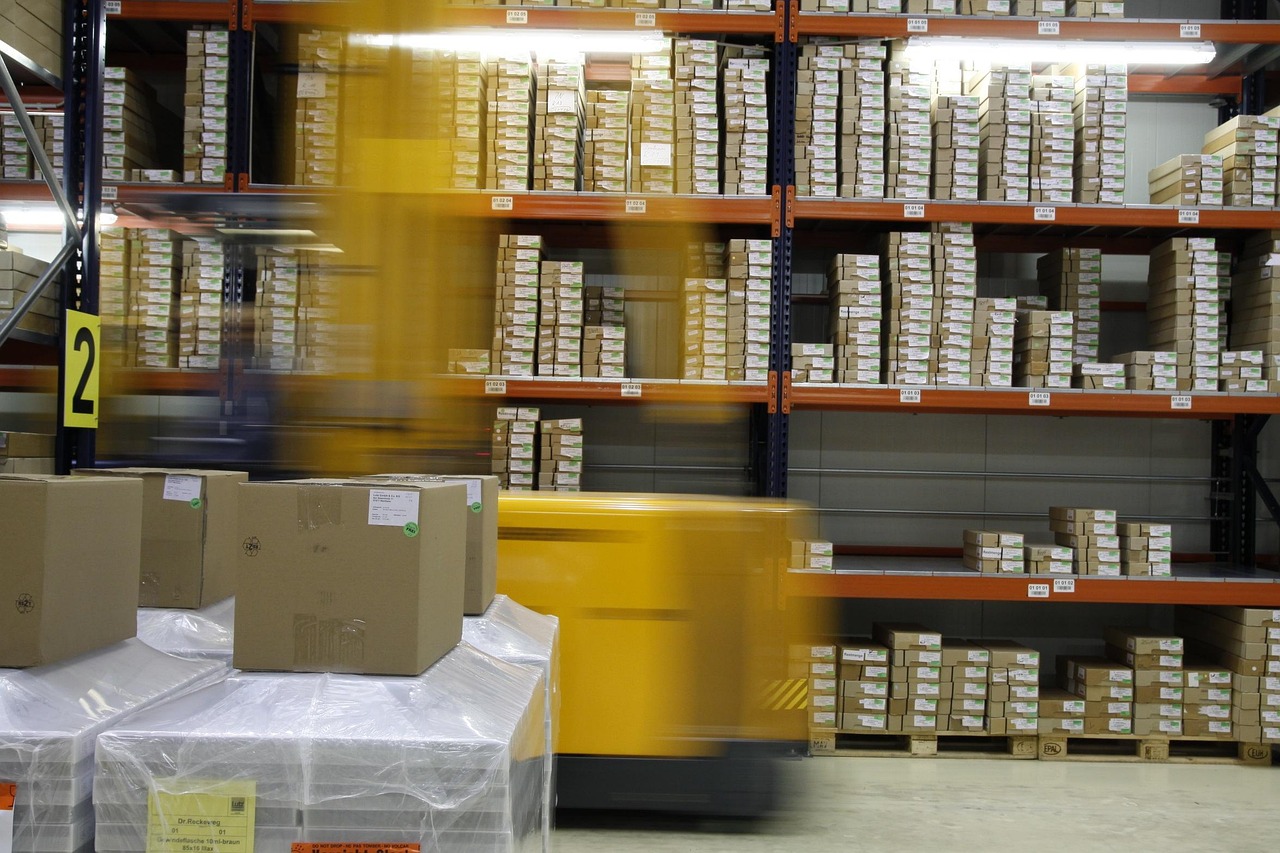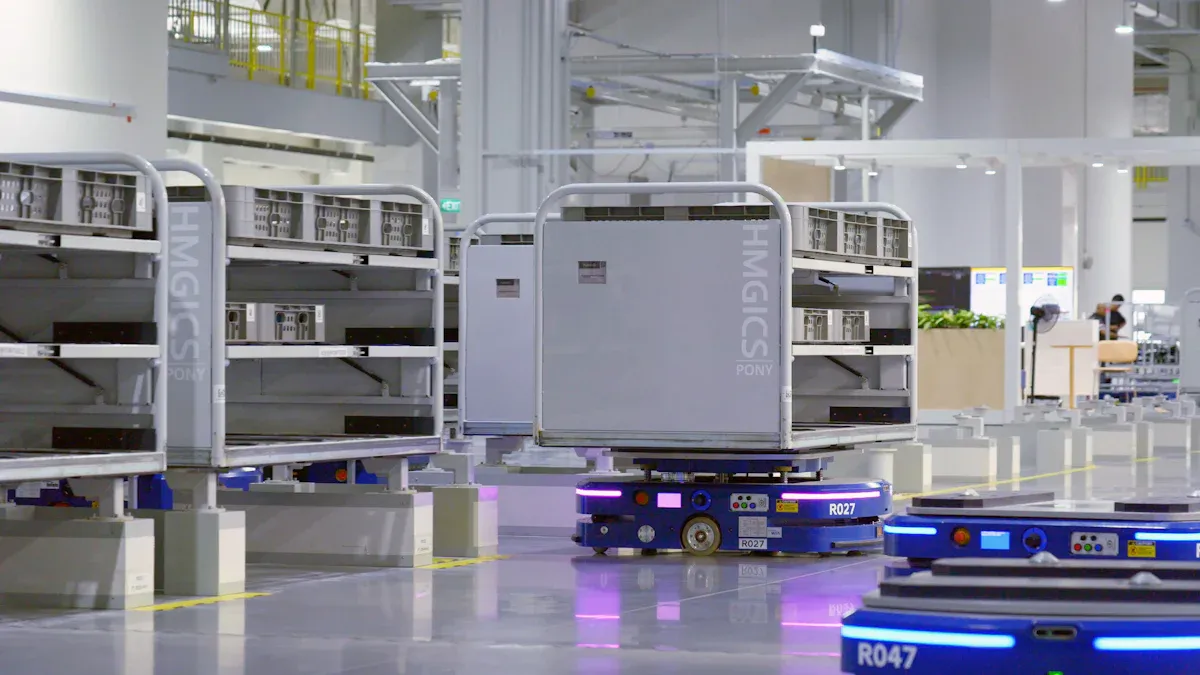What is Smart Warehouse Management and How Does It Work

Smart Warehouse Management uses advanced technology and a warehouse management system (WMS) to automate and control daily warehouse tasks. This system connects devices, sensors, and software to track goods in real time. Employees use data to make quick decisions. The main goals include improving efficiency, boosting accuracy, and reducing manual work.
Smart Warehouse Management helps companies respond faster to changes and keep inventory levels accurate.
Key Takeaways
Smart Warehouse Management uses technology like WMS, sensors, and robots to automate and improve warehouse tasks.
Automation speeds up processes such as receiving, picking, packing, and shipping while reducing errors.
Using real-time data helps workers and managers make better decisions and keep inventory accurate.
Implementing smart systems saves money by lowering labor costs and improving space use.
Successful adoption requires clear goals, employee training, and careful integration of new technology.
Smart Warehouse Management
Definition
Smart Warehouse Management means using advanced technology and a warehouse management system (WMS) to digitize and automate warehouse operations. This approach connects software, machines, and devices to control every step of the warehouse process. Companies use sensors, scanners, and real-time data to track goods and manage tasks. The system helps workers make better decisions and reduces mistakes. Smart Warehouse Management creates a connected environment where every action gets recorded and analyzed.
Note: Smart Warehouse Management does not only focus on technology. It also aims to improve how people and machines work together.
Core Processes
Smart Warehouse Management improves several key warehouse processes. Each process becomes faster and more accurate with automation and data tracking.
Receiving
Workers scan incoming goods with handheld devices or automated scanners. The system checks items against purchase orders and updates inventory records instantly.Putaway
The WMS assigns storage locations for each item. Robots or workers move goods to the correct spots. Sensors confirm that items reach the right place.Picking
When an order arrives, the system creates a picking list. Workers or robots follow the list to collect items. Smart devices guide them to the exact locations, which saves time and reduces errors.Packing
After picking, items move to the packing area. Automated systems or workers pack goods based on order details. The system checks that each package contains the correct items.Shipping
The WMS selects the best shipping method. Workers or machines label and sort packages for delivery. The system updates shipping status in real time, so customers and managers can track orders.
Core Process | Technology Used | Main Benefit |
|---|---|---|
Receiving | Scanners, WMS | Faster check-in |
Putaway | Robots, Sensors | Accurate placement |
Picking | Smart devices, Robots | Fewer mistakes |
Packing | Automated systems | Correct packaging |
Shipping | WMS, Tracking software | Real-time updates |
Smart Warehouse Management brings all these processes together. The system connects people, machines, and data to create a smooth workflow. Companies see better results because every step gets tracked and improved.
Technologies

WMS and Software
A Warehouse Management System (WMS) acts as the brain of Smart Warehouse Management. The WMS tracks inventory, manages orders, and controls daily tasks. It connects with other software, such as warehouse execution systems, to plan and monitor every step. Workers use dashboards to see real-time updates. The WMS helps reduce errors and speeds up decision-making.
A strong WMS gives managers clear data to improve warehouse performance.
IoT and Sensors
Internet of Things (IoT) devices and sensors collect data from every part of the warehouse. Sensors track temperature, humidity, and the movement of goods. IoT devices send this data to the WMS. Managers use this information to spot problems quickly. For example, if a sensor finds a temperature change, the system can alert staff to protect sensitive products.
Robotics and Automation
Robots and automated systems handle many warehouse tasks. They move goods, pick orders, and sort packages. Companies like Reliance and Maersk use robots and smart conveyors to boost speed and accuracy. The table below shows how different companies use robotics to improve their operations:
Company | Robotics/Automation Implemented | Operational Benefits Achieved |
|---|---|---|
Reliance | ASRS systems, multi-level shuttles, smart conveyors, warehouse execution software | Throughput of 270,000 units/day, full automation from receiving to dispatch |
Maersk | Autonomous Mobile Robots, Pallet and Carton Shuttles, Multi-Carton Picking Robots, Pick-to-Light, robotic sorters, conveyors | Processes 100,000 pieces/day, increased storage throughput, retrieval efficiency, real-time inventory visibility |
PAR Pharma | Crane ASRS units, pallet shuttles, integrated warehouse control software | Maximized storage density (4050 multi-deep positions), 100% traceability, reduced throughput times |
ITC | Multi-Deep Mother-Child Shuttle systems, smart software systems | Inbound throughput of 135 pallets/day, outbound 160 pallets/day, pushed industry benchmarks for FMCG logistics |
Landmark Group | Quazzy system combining carton shuttles and robotic sorters | 1,000 sorts/hour, fast and accurate sorting, improved outbound flow |
Piramal PGP | Multi-deep storage with Mother-Child Shuttles, bi-directional lifters, warehouse execution software | Reduced product handling time, increased inventory accuracy, streamlined pallet flow |
These examples show that robotics and automation increase throughput, accuracy, and storage efficiency.
RFID and Drones
RFID (Radio Frequency Identification) tags help track items without manual scanning. Workers place RFID tags on products. Readers pick up signals from these tags to update inventory records instantly. Drones fly through the warehouse to scan barcodes and RFID tags on high shelves. This makes inventory checks faster and safer.
All these technologies work together in Smart Warehouse Management. The WMS collects data from IoT devices, robots, RFID tags, and drones. Managers use this data to make better decisions and keep warehouse operations running smoothly.
Benefits

Efficiency
Smart warehouse management increases efficiency by automating daily tasks. Robots move goods quickly. The WMS assigns jobs to workers and machines without delay. IoT sensors track items and send updates in real time. This system reduces waiting times and speeds up order processing. Workers spend less time searching for products. Companies can handle more orders each day.
Tip: Automated picking systems help teams complete tasks faster and avoid bottlenecks.
Accuracy
Smart systems improve accuracy at every step. Barcode scanners and RFID tags record each item as it moves. The WMS checks orders and inventory levels automatically. Mistakes in picking or packing drop because machines follow exact instructions. Real-time data helps managers spot errors before they become problems.
Process | Traditional Error Rate | Smart Warehouse Error Rate |
|---|---|---|
Picking | 2-5% | <0.5% |
Inventory | 8-10% | <1% |
Cost Savings
Companies save money with smart warehouse management. Automation lowers labor costs because robots handle repetitive jobs. Fewer errors mean less money spent on returns or lost items. Energy-efficient systems reduce utility bills. The WMS helps managers use space better, so companies do not need to rent extra storage.
Lower labor costs
Fewer returns and lost goods
Reduced energy use
Better space utilization
Scalability
Smart warehouses grow with business needs. The WMS can add new users or connect with more devices easily. Companies can increase storage or add robots without stopping operations. Cloud-based systems let managers control multiple warehouses from one dashboard. This flexibility helps businesses expand quickly.
Note: Scalability ensures that companies can meet customer demand during busy seasons or as sales grow.
Challenges
Costs
Smart warehouse management systems require a large investment. Companies often spend money on new hardware, software, and training. Robots, sensors, and IoT devices can cost thousands of dollars each. Small businesses may find these costs hard to manage. Maintenance and software updates add to the total expense.
Note: Many companies see a return on investment over time, but the upfront costs can be a barrier.
A simple breakdown of common expenses:
Expense Type | Example Items | Typical Cost Range |
|---|---|---|
Hardware | Robots, sensors, scanners | $10,000 - $500,000+ |
Software | WMS licenses, cloud systems | $5,000 - $100,000+ |
Training | Staff workshops, onboarding | $1,000 - $20,000 |
Maintenance | Repairs, software updates | $2,000 - $50,000/year |
Integration
Companies often use different systems for inventory, shipping, and sales. Smart warehouse management needs all these systems to work together. Integration can be complex. Some older systems may not connect easily with new technology. Data may not flow smoothly between platforms.
IT teams must solve these problems. They may need to build custom connections or use middleware. Testing and troubleshooting take time. If systems do not integrate well, errors can happen. Orders may get delayed or inventory records may be wrong.
Tip: Companies should check if their current systems support integration before starting a smart warehouse project.
Workforce Adaptation
Employees must learn new tools and processes. Some workers may feel nervous about using robots or advanced software. Training helps, but it takes time. People may worry about job security when machines handle more tasks.
Managers should support their teams during the change. They can offer training sessions and answer questions. When workers understand the benefits, they adapt faster. A positive attitude helps everyone succeed.
Provide clear instructions
Offer hands-on training
Encourage questions and feedback
Employees who feel supported adjust better to smart warehouse systems.
Implementation
Steps
Companies can follow clear steps to start with Smart Warehouse Management.
Assess Needs
Leaders review current warehouse processes and set goals for improvement.Choose Technology
Teams select a warehouse management system, sensors, and automation tools that fit their needs.Plan Integration
IT teams map out how new systems will connect with existing software.Train Employees
Workers learn how to use new devices and software through hands-on training.Test and Launch
Managers run tests to check if everything works. They fix problems before going live.Monitor and Improve
Teams track results and make changes to improve performance over time.
Tip: Start with one warehouse or process before expanding to the whole operation.
Best Practices
Successful companies follow best practices during the transition.
Set clear goals for speed, accuracy, and cost savings.
Involve employees early and provide regular training.
Use real-time data to spot problems quickly.
Keep communication open between IT, warehouse staff, and managers.
Review progress often and adjust plans as needed.
Companies that support their teams and use data make the transition smoother.
Examples
Many global companies have seen strong results from Smart Warehouse Management. The table below shows key metrics and challenges from real-world examples:
Success Metrics / Challenges | Description | Example Companies |
|---|---|---|
Increased Picking Accuracy and Velocity | AS/RS and pick-to-light tools boost order speed and accuracy | Amazon, Alibaba, Walmart, DHL |
Improved Throughput and Operational Efficiency | WMS with automation streamlines storage and retrieval | Amazon, Alibaba, Walmart, DHL |
Reduced Labor Costs | Automation and cobots lower manual labor needs | Amazon, Alibaba, Walmart, DHL |
Enhanced Inventory Accuracy | IoT sensors and RFID give real-time inventory visibility | Amazon, Alibaba, Walmart, DHL |
Faster Shipping and Improved Customer Service | Real-time data and automation speed up order fulfillment | Amazon, Alibaba, Walmart, DHL |
High Initial Technology Investment | Upfront costs for new technology can be high | All mentioned companies |
Need for Skilled Personnel and Training | Teams need expertise to manage new systems | All mentioned companies |
Time-Consuming Transition Process | Integration and training take time | All mentioned companies |
These examples show that Smart Warehouse Management can improve speed, accuracy, and customer service. Companies must also plan for high costs and training needs.
Trends
Innovations
Smart warehouse management keeps changing as new technology appears. Companies now use artificial intelligence (AI) to predict demand and manage inventory. AI helps managers spot trends and make better decisions. Machine learning tools can find patterns in sales and suggest the best ways to store products.
Wearable devices, such as smart glasses and wristbands, guide workers through the warehouse. These tools show directions and order details right in front of their eyes. Workers move faster and make fewer mistakes.
Voice picking systems let workers use voice commands to pick items. They do not need to look at paper lists or screens. This speeds up the picking process and keeps hands free.
Some warehouses use digital twins. A digital twin is a virtual copy of the warehouse. Managers use it to test changes before making them in real life. This helps them avoid problems and improve layouts.
Note: Many companies now use green technology, such as solar panels and energy-saving lights, to lower costs and help the environment.
Future Outlook
Smart warehouse management will keep growing. Experts expect more robots and automated vehicles in warehouses. These machines will handle heavy lifting and move goods quickly.
5G networks will make data move faster between devices. Managers will see real-time updates with almost no delay. This will help them solve problems right away.
Sustainability will become more important. Companies will use more eco-friendly materials and energy sources. They will also try to cut waste and recycle more.
A table below shows some key trends for the future:
Trend | Expected Impact |
|---|---|
More automation | Faster order processing |
5G connectivity | Real-time data sharing |
Green technology | Lower energy costs |
Digital twins | Better planning |
Smart warehouses will help companies work faster, save money, and protect the planet.
Smart Warehouse Management helps companies work faster and more accurately. Technology changes how warehouses operate by making tasks easier and safer. To start, companies should:
Choose the right technology, like a WMS, and add automation step by step.
Train staff and give support during changes.
Track results and improve with data.
Learn from leaders who use new tools to stay ahead.
Companies that follow these steps can build a smarter, more efficient warehouse for the future.
FAQ
What is the main goal of smart warehouse management?
Smart warehouse management aims to make warehouse tasks faster and more accurate. It uses technology to help workers and machines work together. This system reduces mistakes and saves time.
How does a WMS help in daily warehouse operations?
A WMS tracks inventory, assigns tasks, and gives real-time updates. Workers use it to find products quickly. Managers use the data to improve warehouse performance.
Can small businesses use smart warehouse systems?
Yes, small businesses can use smart warehouse systems. Many companies offer solutions that fit different budgets. Cloud-based WMS options help small teams start with less cost.
What types of robots work in smart warehouses?
Smart warehouses use robots for picking, packing, and moving goods. Some robots carry heavy loads. Others help sort packages. These machines work with people to finish tasks faster.
Is it hard for workers to learn new warehouse technology?
Most workers learn new tools with training and support. Companies provide hands-on lessons and answer questions. Workers adapt quickly when they see the benefits.
